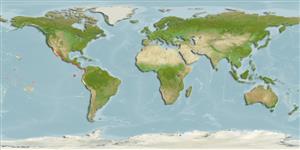Environment: milieu / climate zone / depth range / distribution range
Ekologi
laut dasar (demersal); kisaran kedalaman 15 - 150 m (Ref. 9342), usually 60 - 90 m (Ref. 9342). Tropical; 32°N -
Eastern Pacific: Gulf of California to Peru; including the Galapagos Islands.
Size / Weight / umur
Maturity: Lm ? range ? - ? cm
Max length : 20.0 cm TL jantan/; (Ref. 9342); common length : 15.0 cm TL jantan/; (Ref. 55763)
Body elongate, not very deep, and little compressed, its depth contained 3.2 to 3.8 times in standard length; caudal peduncle very thick; preopercular angle with a broad "spur" consisting of 6 to 12 large spines; first gill arch with 21 to 27 gill rakers; anal rays 8; body grayish brown; flanks with indistinct dark, double, vertical bars; snout and cheeks with yellow stripes; soft dorsal fin with a dark band along its base (Ref. 55763).
Inhabits sand or muddy-sand bottoms. Probably too small in size to be of commercial importance.
Life cycle and mating behavior
Kematangan | Reproduksi, perkembang biakan | Pemijahan | telur-telur | Fecundity | Larva
Heemstra, P.C., 1995. Serranidae. Meros, serranos, guasetas, enjambres, baquetas, indios, loros, gallinas, cabrillas, garropas. p. 1565-1613. In W. Fischer, F. Krupp, W. Schneider, C. Sommer, K.E. Carpenter and V. Niem (eds.) Guia FAO para Identification de Especies para lo Fines de la Pesca. Pacifico Centro-Oriental. 3 Vols. FAO, Rome. (Ref. 9342)
Status IUCN Red List (Ref. 130435)
ancaman kepada manusia
Harmless
penggunaan manusia
Perikanan: tidak ada kepentingan
informasi lanjut
Nama-nama umumSinonim (persamaan)metabolismePemangsaEkotoksikologiReproduksi, perkembang biakanKematanganPemijahanSpawning aggregationFecunditytelur-telurpekembangan telor
AcuanBudidaya airprofil budidaya airStrainGenetikaElectrophoresesDiturunkanPenyakit-penyakitPengolahanNutrientsMass conversion
mitraGambarStamps, Coins Misc.Suara-suaraCiguateraKecepatanTipe renangArea insangOtolithsOtakPenglihatan / visi
Alat, peralatan
laporan khas
muat turun XML
Sumber internet
Estimates based on models
Preferred temperature (Ref.
123201): 15.3 - 22.8, mean 17.1 °C (based on 22 cells).
Phylogenetic diversity index (Ref.
82804): PD
50 = 0.5002 [Uniqueness, from 0.5 = low to 2.0 = high].
Bayesian length-weight: a=0.00955 (0.00587 - 0.01555), b=3.07 (2.93 - 3.21), in cm total length, based on LWR estimates for this species & Genus-body shape (Ref.
93245).
Trophic level (Ref.
69278): 3.6 ±0.6 se; based on size and trophs of closest relatives
Daya lenting (Ref.
120179): sedang, Waktu penggandaan populasi minimum 1.4 - 4.4 tahun (Preliminary K or Fecundity.).
Fishing Vulnerability (Ref.
59153): Low vulnerability (10 of 100).
